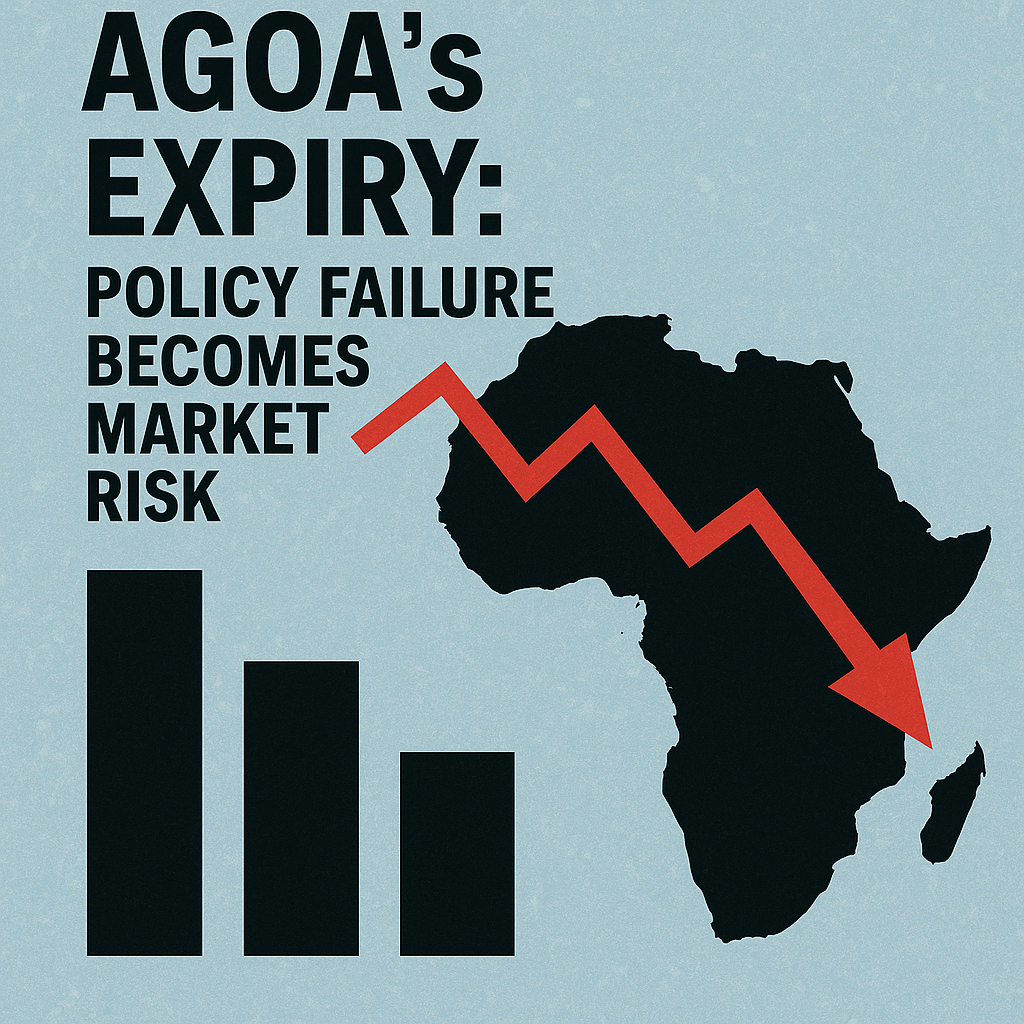AGOA’s Expiry: Policy Failure Becomes Market Risk
AGOA expired Sept 30, 2025, leaving a policy vacuum. Trade fell from USD 44bn highs, apparel orders in Ghana/Lesotho canceled. Risks: KENINT 2032 +50–100bps, GHANA 2034 spreads, FX (KES, GHS, ZAR), equities (PVH, LEVI, NSE:BAT, JSE:ANG).

The African Growth and Opportunity Act (AGOA), Washington’s flagship trade preference framework with Sub-Saharan Africa, officially expired on September 30, 2025. The sunset date was no surprise — AGOA had been legislated to end this year — but the failure of Congress to renew or replace it has created a policy vacuum with consequences reaching from African factory floors to global bond markets.
Rosa Whitaker, former U.S. Assistant Trade Representative for Africa and co-chair of the AGOA Alliance, described the impact starkly in a reflection published on AllAfrica. She noted that apparel factories in Ghana and Lesotho have already seen orders cancelled, investors have pulled back, and jobs are being lost. Whitaker stressed that AGOA was more than symbolic: since its creation in 2000, two-way U.S.–Africa trade rose from USD 28 billion in 2001 to USD 44 billion in 2024, while exports diversified from crude oil into autos, apparel, food, and specialty goods. By her estimates, the program sustained more than 1 million African jobs and about 500,000 U.S. jobs, embedding African supply chains into brands like PVH Corp (NYSE:PVH) and Levi Strauss & Co (NYSE:LEVI).
What has unsettled markets is not the date itself but the political inaction surrounding it. In past decades, renewals were bipartisan; this time, multiple reauthorization bills — including the AGOA Renewal and Improvement Act of 2024 — never reached a vote. Analysts at CSIS, Carnegie, and the Institute for Security Studies warned throughout the year that political appetite was fading, and that extension was “no longer a formality.” With no successor deal, investors now face abrupt uncertainty.
The market consequences extend beyond cancelled apparel orders. For frontier debt, the risk is deterioration in external balances. Kenya’s 2032 Eurobonds (KENINT 6.875%) and Ghana’s 2034s (GHANA 8.125%) could see spreads widen by 50 to 100 basis points if export earnings falter, echoing past episodes when trade shocks eroded FX inflows. Currency markets are also sensitive: the KES (Kenyan Shilling) and GHS (Ghanaian Cedi) remain vulnerable to depreciation, while the ZAR (South African Rand), less reliant on AGOA itself, may still absorb regional contagion.
Corporate exposures are equally at risk. Kenyan exporters such as BAT Kenya (NSE:BAT) and Kapchorua Tea (NSE:KAPC) face higher tariff costs that could compress margins. South African auto and mining players — including AngloGold Ashanti (JSE:ANG) and Harmony Gold (JSE:HAR) — risk losing competitiveness in U.S. markets, while U.S. apparel majors may see higher input costs if low-cost African suppliers are forced to scale back.
The geopolitical implications are clear. China has already extended zero-tariff treatment to 98 percent of goods from least-developed African states, providing an immediate alternative for displaced exports. Beyond garments and food, this could reorient flows of strategic minerals such as cobalt, manganese, and platinum group metals into Chinese supply chains — a direct challenge for U.S. electric vehicle and clean energy industries that depend on African inputs.
From a market perspective, AGOA’s expiry represents less a scheduled sunset than a shock of political neglect. The program’s lapse has already undermined export orders and could destabilize frontier debt and FX markets. It has also raised supply chain risks for listed consumer companies in both Africa and the U.S., while reinforcing Beijing’s trade dominance in Africa.
Yet a self-critical lens is needed. Some of these projections — such as the +50–100bps spread impact or the direct equity linkages to listed firms — are scenario-based extrapolations, not observed market moves. While historical precedent suggests that frontier bonds and currencies react sharply to trade shocks, the scale of impact will depend on broader factors: global liquidity, IMF support programs, central bank reserves, and alternative market access via AfCFTA or the EU. Likewise, not all revenues of BAT Kenya, Kapchorua Tea, or South African miners are AGOA-dependent; the exposures are directional, not absolute.
Still, the core point stands: the absence of U.S. action has created a vacuum that investors cannot ignore. Markets trade not only on scheduled events but on political reliability. In this case, Washington’s failure to extend or replace AGOA has injected volatility into African assets, highlighted U.S. supply chain risks, and accelerated Africa’s tilt toward China. Unless Congress and the White House deliver a credible successor framework, investors should expect the policy vacuum to remain a source of premium in African risk assets — and a reminder that in global markets, inaction can be as disruptive as policy itself.





